You are using an out of date browser. It may not display this or other websites correctly.
You should upgrade or use an alternative browser.
You should upgrade or use an alternative browser.
gluing planks together to make a laminate.
- Thread starter jackieschmidt
- Start date
Jonnyofalltrades
Silver $$ Contributor
That publication is really a good resource for understanding wood better.When gluing up important pieces I try to use boards that have acclimated to the current weather conditions, which only takes a few minutes a day. On each board simply measure with a dial caliper at both ends and about every 2’ and write the measurement on the board. I write on the spot of the original measurement so additional measurements can be made on the same place. The ends of the board shed or absorb moisture 10x as quickly as the middle and measurements taken just a few days apart will show this. Most wood at retailers is poorly dried and has extra moisture - I would predict the ends will be shrinking a measurable amount every day during the dry months, or growing if during the wet months in states with big humidity swings. The ends will eventually stop moving, but the middle will take many more days or weeks.
During the kiln drying process if temperatures and humidity aren’t kept within proper ranges, many different internal stresses can build up that will stay with the board - often generically referred to as case hardening. If a board has a lot of extra movement during a cut, like dramatically pinching the blade or spreading out, it’s best used for small or thin areas, or cut up and used in the smoker.
USDA has researched all aspects of kiln drying to the point it’s very well understood. If anyone is curious about it, there’s a great free publication online.
Dry kiln operator's manual
www.fpl.fs.usda.gov
Goes to prove that you can't just pigeonhole materials as "kiln-dried/bad" or "air-dried/good".
I have had some rather wild reaction wood out of pieces that I cut and seasoned myself.
Another great read for wood geeks is Bruce Hoadley's "Understanding Wood".
Jonnyofalltrades
Silver $$ Contributor
It can actually get that hot?I would strongly advise against carpenter glue (Titebond, PVA of all kinds) - as a professional woodworker I’ve seen dramatic failures of it at only slightly elevated temperatures. In 100 degree weather, leaving a cabinet assembled with pva glue out in direct sunlight further raising the wood temp is asking for a quick self disassembly. I personally watched a new piece of furniture that took 160 hours of work, just fall apart at the joints while being carried after being left outside in the sun on a 105 degree day.
This is an easy idea to prove for yourself. Take a couple of 2’ boards and run a bead of glue across one far end covering 4-6” and clamp until dry. Set it in your car in the middle of summer for an hour and the roughly 140 degrees plus added heat of direct sun will allow the boards to be easily pulled apart by hand.
Up here we generally have more cold than heat to deal with. Six months straight with snow on the ground.
Then mosquitoes....
Lol Sounds like you’re safe.It can actually get that hot?
Up here we generally have more cold than heat to deal with. Six months straight with snow on the ground.
Then mosquitoes....
butchlambert
Site $$ Sponsor
West Systems as mentioned above. Use carbon fiber cloth between each lamination. I also agree on air dried wood. Remember there is a difference between dry and cure. I buy my walnut from Roger Vardy in Australia. If you can find somebody to vacuum bag it instead of clamps, you would be better off.
Walt Krafft
Gold $$ Contributor
The vacuum bag is the best clamping system for laminating.
Resorcinol Adhesives Characteristics and uses.
Resorcinol glue has a long history as a boatbuilding adhesive. It is a strong, waterproof and reliable glue for boatbuilding.
www.christinedemerchant.com
Jackie, this is or was common around sailboats. I recall my Dad using it. The color of the version that he used was a dark burgundy, similar to an epoxy, but not as viscous.
Alex Wheeler
Site $$ Sponsor
Jackie,
Id give these guys a call. This stuff is what we make most of our stocks out of.

Id give these guys a call. This stuff is what we make most of our stocks out of.

jackieschmidt
Gold $$ Contributor
I will. Thanks.Jackie,
Id give these guys a call. This stuff is what we make most of our stocks out of.

joshb
Gold $$ Contributor
Hey Jackie! I checked my pile of wood. I have oak and walnut that’s been air dryed for 50 years on the east coast, then 4 years in Texas. I have plenty of epoxy to glue it up with if you’re gonna shoot it in Hell’s Kitchen and don’t want regular wood glue. Let me know.
Josh
PS: I’ll need a drawing or plan.
Josh
PS: I’ll need a drawing or plan.
Last edited:
I use West Systems epoxy to do laminates. Tough to find a better one imho, just works. The two parts are 105 and 207.
Arrow Wood Finish is the best oil I’ve found, I’d just send it to BC’z though .
Five part laminate of Tiger maple.
View attachment 1496004
Mother
Skedaddle Shooter
Gold $$ Contributor
More laminations can create some additional stability, up to a point. I’m experimenting with building a couple stocks. I’ve been a woodworker for a very long time and figured I’d give it a shot. The top blank (the picture at the bottom) has carbon fiber in between the layers and I used West Systems epoxy. It is what you want to use if you are laying up fabric in the lamination. You don’t want to starve the joint so just enough pressure to make full contact with the laminations and fabric, leaving ample epoxy in the joint. The bottom blank is just wood, so I used a Tight Bond III. I’ve used this for years and never had a failure. With it you want to squeeze the daylight out of the joint so more clamps and a lot of pressure. True oil will work, I’ve used it on projects and of course lacquer as well. My latest experiment I’m using a hard wax product called Rubio Monocoat with a ceramic hard coat over it. So far I like it but am still finishing the stock. BZ’s can do a fantastic high gloss automotive finish as well. So you have a lot of choices, good luck I am looking forward to seeing your progress. These blanks are eastern maple and black walnut.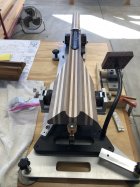
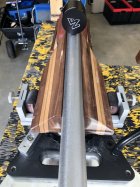
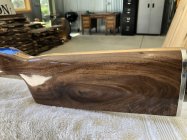 be interested in seeing your progress.
be interested in seeing your progress.
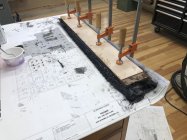
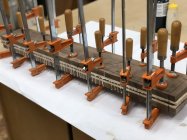


 be interested in seeing your progress.
be interested in seeing your progress.

Last edited:
joshb
Gold $$ Contributor
Epoxy can be a little tricky for a first timer. Too much clamping pressure starves the joint. Too little can leave a gap. That’s why I use and suggest the Titebond. Clamp the Crap out of it and you have a good laminate joint.
I put a glued up piece in an oven at 225 for an hour and a half. I managed to pull it apart…..with a crow bar. I’m going to test epoxy next but I think I know what’s going to happen. When guys are pulling glued in actions apart, they apply heat to soften the epoxy.
I’d say the take away and best advice is don’t leave your gun out in extreme heat. You may have problems. Treat your gun like a faithful pet and you’ll be fine.
I put a glued up piece in an oven at 225 for an hour and a half. I managed to pull it apart…..with a crow bar. I’m going to test epoxy next but I think I know what’s going to happen. When guys are pulling glued in actions apart, they apply heat to soften the epoxy.
I’d say the take away and best advice is don’t leave your gun out in extreme heat. You may have problems. Treat your gun like a faithful pet and you’ll be fine.
I have used West System for years on wooden boats. It's my go-to on any wood or fiber. Friends from a past life used it on their ice boats.
It's a 5:1 mix ratio. I use a scale but still buy their "calibrated" hand pumps.
On occasion I've used the alumina or glass bead fillers, but never in laminate or fiber lay-ups.
You do not want to mix a big pot of it, like 1/4 of a big Folgers can - it'll cook itself.
It's a 5:1 mix ratio. I use a scale but still buy their "calibrated" hand pumps.
On occasion I've used the alumina or glass bead fillers, but never in laminate or fiber lay-ups.
You do not want to mix a big pot of it, like 1/4 of a big Folgers can - it'll cook itself.
Skedaddle Shooter
Gold $$ Contributor
Hi @joshb , your post was my inspiration for giving this a shot. Thanks for all the time you have put into bringing the rest of us along on a stock building journey. Your stocks are beautifully shaped. I agree on the expoy being a bit tricker. I was just referring to butchlambert’s suggestion on laying up carbon fiber in the blank. I imagine it would add stiffness to the stock and it adds to the blank visually. I used it in my first prototype. It’s kind of hard on the tooling and I think the all wood laminate should be plenty stiff so the other couple I’m working on are just wood. The proof will be is if they shootEpoxy can be a little tricky for a first timer. Too much clamping pressure starves the joint. Too little can leave a gap. That’s why I use and suggest the Titebond. Clamp the Crap out of it and you have a good laminate joint.
I put a glued up piece in an oven at 225 for an hour and a half. I managed to pull it apart…..with a crow bar. I’m going to test epoxy next but I think I know what’s going to happen. When guys are pulling glued in actions apart, they apply heat to soften the epoxy.
I’d say the take away and best advice is don’t leave your gun out in extreme heat. You may have problems. Treat your gun like a faithful pet and you’ll be fine.
joshb
Gold $$ Contributor
Well…..I’m happy to have sparked your project. My endeavor was initiated by the high costs of a good stock and the absence of a design I liked. Bravo for taking up the torch. It looks like you’ve got it nailed! Nice work!
I thought about using carbon fiber. Still might.
I thought about using carbon fiber. Still might.
joshb
Gold $$ Contributor
Ha! Yup! Get everything ready and get it on the wood FAST! Even small batches will cook off if left too long in the mixing container!I have used West System for years on wooden boats. It's my go-to on any wood or fiber. Friends from a past life used it on their ice boats.
It's a 5:1 mix ratio. I use a scale but still buy their "calibrated" hand pumps.
On occasion I've used the alumina or glass bead fillers, but never in laminate or fiber lay-ups.
You do not want to mix a big pot of it, like 1/4 of a big Folgers can - it'll cook itself.
Similar threads
- Replies
- 4
- Views
- 1,274
Upgrades & Donations
This Forum's expenses are primarily paid by member contributions. You can upgrade your Forum membership in seconds. Gold and Silver members get unlimited FREE classifieds for one year. Gold members can upload custom avatars.

Click Upgrade Membership Button ABOVE to get Gold or Silver Status.
You can also donate any amount, large or small, with the button below. Include your Forum Name in the PayPal Notes field.
To DONATE by CHECK, or make a recurring donation, CLICK HERE to learn how.

Click Upgrade Membership Button ABOVE to get Gold or Silver Status.
You can also donate any amount, large or small, with the button below. Include your Forum Name in the PayPal Notes field.
To DONATE by CHECK, or make a recurring donation, CLICK HERE to learn how.










